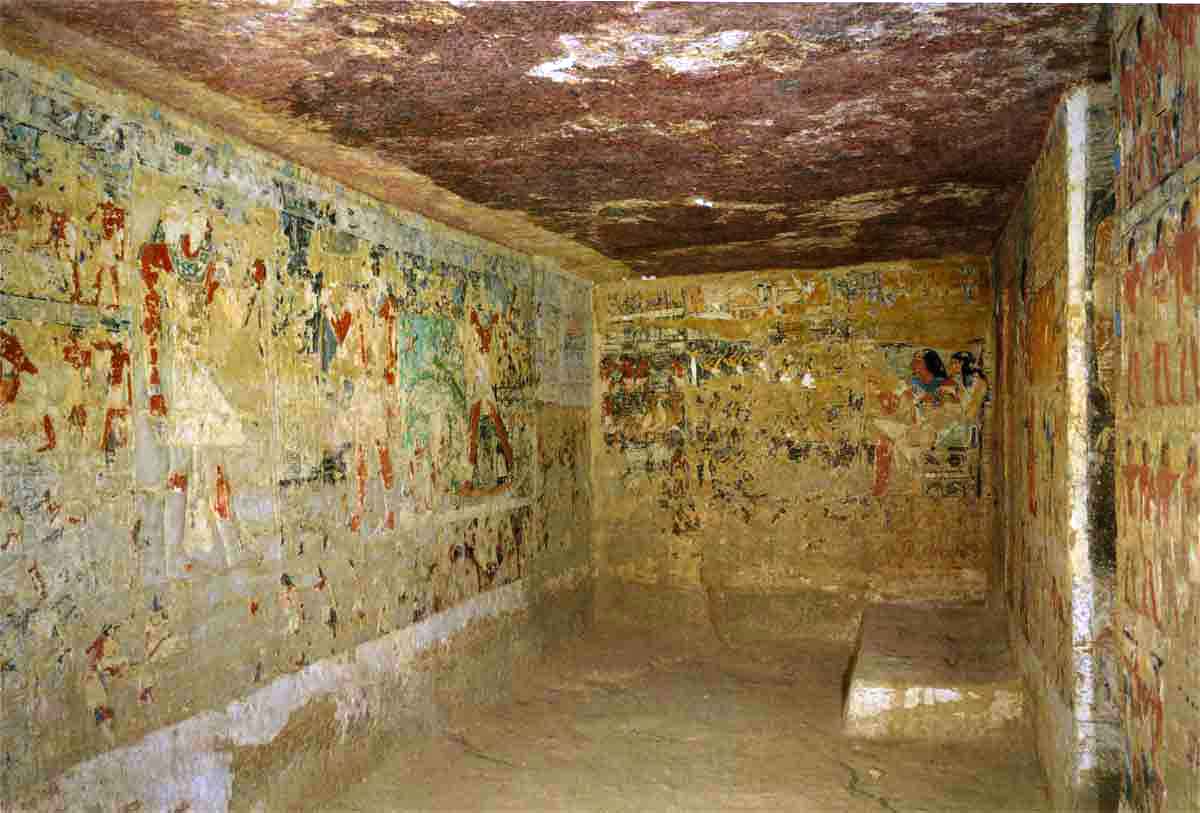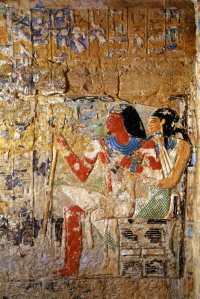La mastaba de Merefnebef , situada en Saqqara a 120 metros al este de la pirámide de Netjerykhet-Djoser, fue descubirta el año 1997 por el equipo de “The Polish Centre of Mediterranean Archeology de la universidad de Varsovia ,dirigido por el profesor Karol Mysliwiec. Merefnebef fue un visir que ejerció su cargo a principios de la dinastía VI. Imagenes de osirisnet.  
|
|
  |
Hay un libro titulado
Saqqara I The tomb of Merefnebef escrito por el profesor Karoñ Mysliwiec y otros autores.
En osirisnet han publicado parte de ese libro.
http://www.osirisnet.net/mastabas/merefnebef/e_merefnebef_01.htm
Y poco a poco ,podemos ir comentando todo lo que se encuentra en esa mastaba y sobre el visir.
Desgraciadamente esta mastaba está cerrada al público 
 mapa que indica la localización de la tumba
Posiblemente este personaje tuvo cuatro esposas, o quizás algunas fueron concubinas, pero las cuatro mujeres aparecen nombradas en su capilla. Sus nombres eran: Iret, Metjut, Nebet, Sesheshet. Por cierto, se hallaron dos esqueletos de mujeres en los anexos a su sepulcro. Su madre se llamaba Tueste y su nombre está representado en la tumba . No aparece el nombre de ninguna hija y aparecen los nombres de sus tres hijos: Manefer, Men y Merefnebef/Fefi. Se llamaba este hijo como su padre y su mujer y su hijo Hemi aparecen también representados en la tumba. En la foto: el profesor Karol Mysliwiec en la tumba de Merefnebef 
Upper sub-register : preparing a bed Two men are represented kneeling on a white mattress, smoothing the surface. The mattress rests on a thick floor, suspended behind a row of 12 vertical poles; these are black, as are the other elements of the bed. Its surface is inclined slightly downwards toward the foot of the bed. At its right end (the top) is the headrest lying on its side. Below the bed are 4 tables (or perhaps boxes), possibly intended for bed linen. Merefnebef Mastaba source: osirisnet.website 
|
|
  |


The mastaba tomb of 6th Dynasty vizier, Merefnebef (also known as Unisankh and Fefi), is located to the west of the step pyramid of Djoser at Saqqara. A mastaba tomb, also known as per-djet “house for eternity”, is a flat-roofed, rectangular structure with outward sloping sides, constructed from mud-brick or stone. Mastaba tombs were the standard tomb-type in Pre-Dynastic and Early Dynastic Egypt.
Merefnebef first served under the Old Kingdom pharaoh, Teti, and is believed to have become a vizier during the reign of the following pharaoh, Userkare. He continued to hold the office into the reign of Pepi I.
Merefnebef held many titles – a staggering 34 are listed in his tomb, including ‘Overseer of the scribes of the royal records’ (one of the most important administrative titles during the 6th Dynasty, held almost exclusively by viziers), and ‘Guardian of the pyramid of Teti “The places-of-Teti-are-enduring”‘. He also held several titles with the phrase ‘privy to secrets’, including ‘Privy to secrets of the House of the Morning’, the most important and highest title of the ‘privy to secrets’ group. It is believed that the holders of this title may have assisted the king in preparations for divine rituals. It is evident that Merefnebef enjoyed a position that placed him very close to the pharaoh.
Merefnebef (II) and his wife, Hemi, seated before offerings (Source: OsirisNet).
Many of Merefnebef’s family members are named in the tomb, including his wives and concubines, his mother, and his three sons. The names of the two eldest sons, Manefer and Mem, have been chiselled out. His youngest son, Merefnebef (II), is depicted in the tomb with his wife, Hemi (left).
It is believed that Merefnebef (II) may have partially usurped the mastaba after his father’s death, in order to use it for himself. It is possible that after the vizier, Merefnebef, died, his three sons fought, and that Merefnebef (II) was successful. He may have decided to restore the badly damaged tomb and to modify it in his favour, by adding images of himself and his wife, Hemi.
The tomb of Merefnebef is very beautifully decorated and, although badly damaged, its beauty remains. Scenes of daily life decorate the walls, including scenes of fishing (below left), fowling, and agriculture. The marsh scenes (below right) are particularly beautiful – the colours are astonishingly fresh and bright considering their age (some 4,500 years old).
There are also scenes of butchery, baking bread, brewing beer, and a jewellery workshop (below). In this scene, two pairs of craftsmen are seated at two tables stringing collars . The similarity between the two groups indicates that they possibly represent the same two craftsmen, seen from different angles, in accordance with the Egyptian aspective.
Rather that depicting scenes from one perspective , e.g. a room seen from one corner, Egyptian artists took the most characteristic aspects to build up a composite aspective image. People, for example, are often depicted with legs and face in profile, but the shoulders and torso full frontal – this is to enable both arms to be seen. This creates a beautiful, yet unrealistic, perspective which is known as the aspective
Large beautiful scenes show Merefnebef, seated with one of his wives, under a kiosk, watching dancers and harpists (above right). In the upper and lower registers, three dancers display movements of an unrealistic ‘acrobatic nature’. Their bodies are almost horizontal, and their left legs and both arms are extended vertically (left). Each dancer is clothed in a short white kilt, leaving their breasts exposed. Their hair is braided and they wear a ‘pom-pom’ on the end of the braid. A woman stands behind each group of dancers, clapping out the rhythm with her hands.
A list of offerings has been carved in the hieroglyphic script, and the signs have been beautifully painted (below).
A roughly carved white limestone sarcophagus was discovered inside the tomb (below). Unfortunately, the burial chamber had been looted (possibly shortly after the burial took place), and the body had been dragged out and laid on top of the sarcophagus. Upon modern discovery, only the skeleton remained. The bones remained in an anatomical position (with exception of the skull) which could suggest that the robbery occurred before the decay of the soft tissues.
http://egyptianaemporium.wordpress.com/2012/10/02/tuesday-tomb-the-mastaba-of-merefnebef/
|
|
|
|




No hay comentarios:
Publicar un comentario